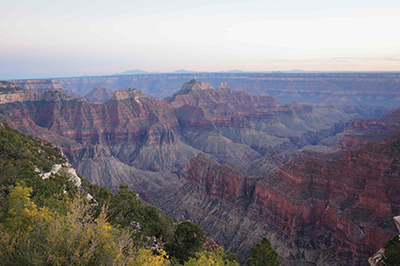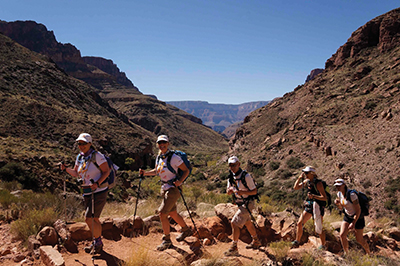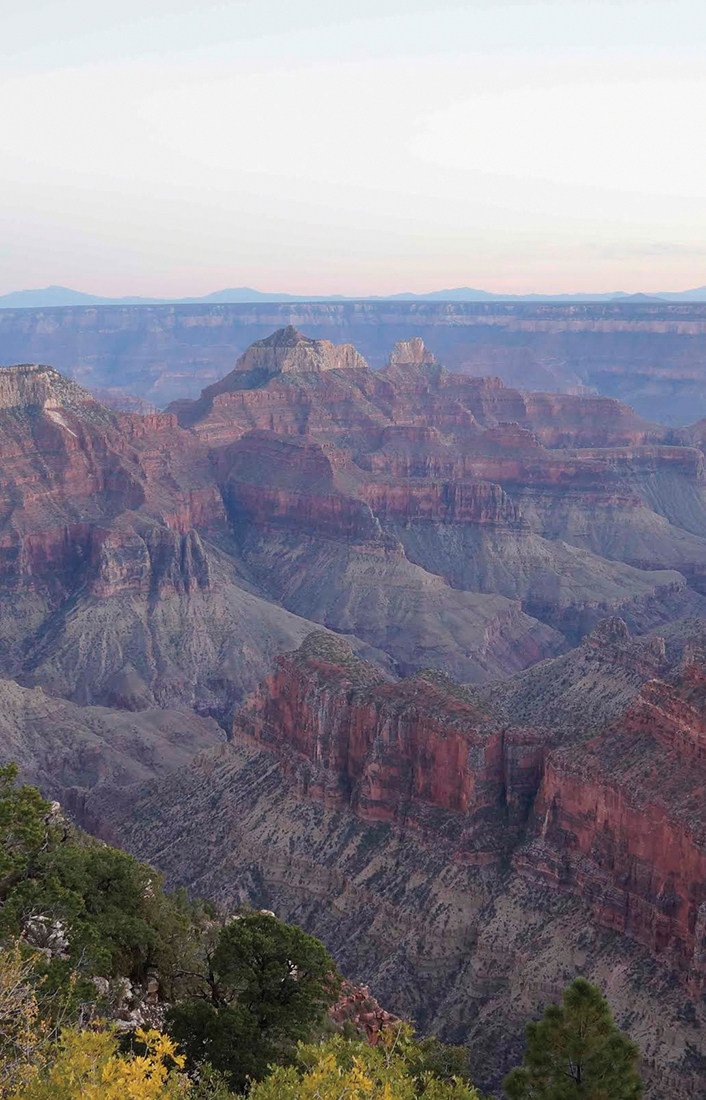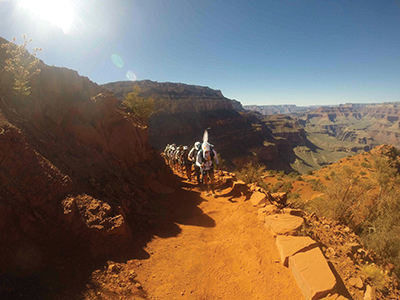
IT’S 3:30 A.M., and I’m huddled with a group of 30 strangers on the South Rim of the Grand Canyon, shivering in the early October chill. I’ve never visited the park and am eager to take in “the most sublime spectacle in nature,” as explorer John Wesley Powell rhapsodized — but the only thing visible in the three-foot glow of my head lamp is my unnervingly clean Saucony trail runners. I’ve already broken the first rule of hiking: never wear new shoes on a long outing. So. Dumb, I think as I gaze at my 10-day-old sneakers. We’re about to embark on a two-day, 46-mile, rim- to- rim- to- rim trek. By tonight, if all goes according to plan, we’ll be sleeping off the day’s lactic acid in a cabin on the North Rim — and by early evening tomorrow we’ll be clinking champagne glasses back here on the South. Footwear gods (and 52-year-old body) willing.
We’re an improbable lot: firefighters, young moms, two guys in the military, a handful of Tony Robbins life coaches, a tight end for the Pittsburgh Passion (a professional women’s football team) and, at our emotional axis, one remarkable 26-year-old, Kristen Lucci, who by all rights shouldn’t be here — as in alive, on this earth — at all. In 2009, after undergoing surgery for a congenital brain condition, she developed a dangerous infection that was nearly fatal. She recovered, thankfully, and is here, as we all are, thanks to Robyn Benincasa, founder of Project Athena, a nonprofit designed to give women who’ve faced life-threatening illnesses the opportunity to fulfill an adventurous dream — like hiking the R2R2R. Everyone in the group has his or her own reasons for raising the $2,500 donation required to join a Project Athena outing, but we’re all united by a belief in the organization’s mission. “This isn’t about setbacks,” says Benincasa, “it’s about comebacks.” As for me, when a mutual friend finagled a gratis spot on this trek in exchange for helping out, I leapt at the opportunity.
Benincasa knows something about comebacks. A world champion adventure racer whose team won both the Eco-Challenge and the Raid Gauloises, she was told in 2007 that she’d never run again thanks to crippling hip arthritis. Four surgeries later, she set a Guinness world record in her kayak. Then another. Then one on a paddleboard. (Oh, and she’s back to running.) Project Athena was born of her need to transform speed bumps into launch pads.
As our steamy exhales form an eerie halo in the darkness over our heads, Benincasa waves us in close for her pre-hike “sermon” — part pump-up speech (“By tomorrow night, you will be one of the very few people on earth to have hiked all the way across the Grand Canyon and back in two days”), part adventure-racing, team-building manifesto (“We’re here to give of ourselves. To help, to be helped, to feed, to be fed”). As we tromp toward the Bright Angel trailhead, I feed off Benincasa’s confidence. Honestly, the woman’s biceps alone are enough to inspire allegiance. If I’m going to follow anyone into an ancient geological abyss at 4 in the morning, I decide, it might as well be her.
Into the Abyss
After a dark and dusty 2.5- hour, 6,800-foot descent (bandanas or Buffs are mandatory gear so you don’t inhale dried mule poop), we reach the canyon floor, and the sun begins, yard by yard, to illuminate the soaring walls, transforming what looked like dull gray monoliths into striated palettes of color, pattern and light — an inscrutable, inspiring geologic record of life on earth. I need to look down to watch my footing, but I have to look up; I’d rather stumble than miss this show. And there’s so much to see. As we wend our way alongside the churning Colorado River (a rugged beauty in itself), every bend reveals yet another breath snatching view. The splendor makes us all a little giddy. Valerie, the football player, bursts randomly, and at top volume, into stream-of-consciousness pop songs, from “Walk This Way” to “The Climb.” The Tony Robbins folks chatter enthusiastically about gratitude and living in the moment. I soak it all in, my cheeks sore from smiling.

As we walk, we practice some of the rules Benincasa picked up in her years of adventure racing: we share food, stash sweaty clothes in each other’s packs, remind everyone to drink, drink, drink. (Even though the canyon is far cooler in October than in the preceding months, it still often reaches the low 80s by midday.) By the time we fetch up at Phantom Ranch, a 1920s outpost with a lodge and cabins about 10 miles from where we started, the all-for-one-and-one-for-all vibe has worked its alchemy. We’re a team.
This is our longest stop of the day, and it’s only 15 minutes (adventure racers have a bias toward forward motion), so we rush to fill water bottles, snarf down smooshed PB&Js, change into shorts and T-shirts, reapply sunscreen. Not everyone is up for hurrying, though. One woman’s feet are an agonizing bloom of blisters. Another few are light-headed with dehydration. Lucci is feeling hot and weak. By the time we’re zipping our packs and heading out, Benincasa and her support crew (all of whom are as crazy-fit as she is) have persuaded Lucci and Ivor, a kindhearted Australian man who’s also hit the wall, to hook up to towlines — five-foot bungee cords that allow a stronger hiker to assist a struggling one. Lucci tells me, “I need to do this for everyone’s sake. We need to get to the other side as a group. This is the best way I can help.”
Stronger Together
Now it’s my turn to feel choked up — and a little idiotic. I’d been thinking of the towline as a sign of weakness, but from a teamwork perspective, it’s a gesture of generosity — even strength. Humbled and moved, I resolve to adopt Lucci’s egoless attitude for the next 36 hours — to give and receive metaphoric towlines whenever I have the chance. I find them everywhere — in conversations that distract me from my discomfort, in silly jokes, in offers of Fritos, my new favorite trail food. (Benincasa had suggested we pack “O” foods — Fritos, Cheetos, Doritos; I brought along chia seed bars, to my profound regret.)
Catalina, my lovely Ecuadorean roommate on the trip, has hiked the canyon with Project Athena once before and adopts a proprietary concern for my welfare. “Eat a little bit every 30 minutes,” she reminds me over and over. Pablo, one of Benincasa’s guides, lets me play around with the towline, first hooking me up, then insisting I tow all 200-plus pounds of him. I stagger maybe 50 paces before I wave him off, spent. And when Tracy, a friendly blond insurance saleswoman from Florida, runs out of water because her backpack bladder sprung a leak, I stay by her side and do my best to keep her hydrated.
Even with all the togetherness, there’s plenty of time for quiet reflection during two 12-hour days of hiking, and I revel in being away from deadlines and responsibilities. If ever there was an opportunity to practice being present in the moment, this is it. As my footfalls beat out a steady pace, I let their cadence anchor my mind in the now. For long stretches, I feel like I have ceased to exist — the me who is a wife, a mom of two teenage boys, a freelance writer. I’m an insignificant body swallowed whole by nature’s beauty.
We finally crest the North Rim at 6, where we share long hugs, high fives and lots of tears — a combination of fatigue and exhilaration has left most of us weepy and giddy — then head straight to the spacious wood and stone deck overlooking the canyon, where we gawk and marvel at the distant landscape we had crossed. My legs, which felt fine before I sat down, are so stiff when I try to stand I’m surprised they don’t audibly creak. Some of the younger folks talk about gathering at the bar, but I wolf down some pizza and salad and retreat to the cabin I’m sharing with Catalina and one other woman — where I’m snoring (or so Catalina tells me) by 9.
Down and up
On day two, after a short but sound night’s sleep (we’re on the trail by 3:45 a.m.), we drop 5,850 feet on the North Kaibab trail to the canyon floor, and by the time we pass Cottonwood Campground, about 7 miles in, I’m starting to feel the first insidious creep of fatigue. Our destination on the South Rim looms far above us and 15 miles away — impossibly distant — so I try to put that goal out of my mind and remind myself of something a mountain biking friend once told me on a steep pitch: “When I start getting tired,” he said, “I just tell myself, This is what I’m doing right now.” That phrase, with its Zen-like simplicity, is strangely liberating. Moments are fleeting. This, too, shall pass. Why not embrace reality?
Before our final, 7-mile ascent on the South Kaibab trail to the South Rim, we stop again at Phantom Ranch. Benincasa warns us we’re in for a long, hot slog. “Fill those water bottles, people. You’re going to need every drop.” She’s right, as usual. I’m not thrilled with the extra weight in my pack, but I’m grateful for the fluid. The South Kaibab, with its sandy switchbacks and uneven wooden steps, is steep and exposed. I suck down water like a fiend, trying to beat back the hazy buzz that’s settled in my brain, but I still have to bow my head in concentration to push forward. (The posture gives me ample time to observe my trail-christened shoes: respectably filthy, delightfully comfy.)
After a couple of tough hours, we stop to take a group photo, and I suddenly realize we’re seeing more and more day hikers. We’re almost there. Adrenaline floods my body and whisks the mist from my mind. From then on, I stride toward the summit feeling strong — and when I finally top out more than an hour later, fist-pumping like a prize fighter, I spot our five companions, including Lucci and Ivor, who took the van back to the South Rim and instead of hiking. It could have been any of us, really; dehydration, blisters and fatigue can overwhelm even the fittest hikers. But today they had the grace to put aside their goal of conquering the canyon so we could fulfill ours more easily. As I watch the group reunite, I’m reminded of something Benincasa said yesterday morning — a lifetime ago: “Embrace this day, and love being alive — and remember: We’re not taking a hike, we’re giving a hike.” Amen, sister. Amen.
What to Pack
- 1, 100-ounce water bladder plus two water bottles (on the main trails you can refill water bottles every 6 miles)
- You’ll need to eat about 100 calories every hour, so bring food (my favorites: Fritos and Krave jerky)
- Hydration tablets to put in your water
- Hiking poles help tremendously on both the uphill and the downhill
- Bandana or Buff
- Headlamp
- Brimmed hat and sunscreen
- Blister kit
- Clothes for layering
- Anti-inflammatory pain reliever
For more information on hiking the Grand Canyon, visit nps.gov/grca/planyourvisit. For more information on Project Athena, visit projectathena.org.
This article originally appeared in Marin Magazine’s print edition under the headline: “Shooting the Rim“.



